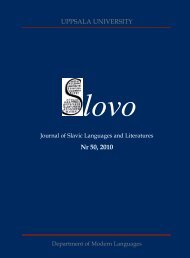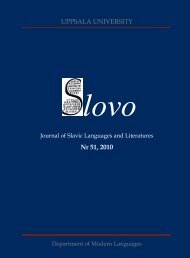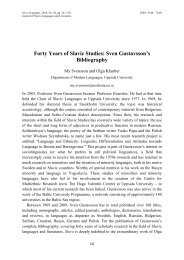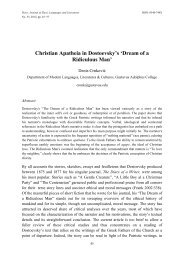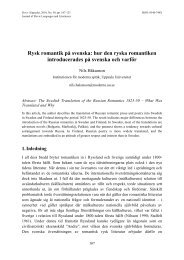Full text PDF - Index of - Uppsala universitet
Full text PDF - Index of - Uppsala universitet
Full text PDF - Index of - Uppsala universitet
You also want an ePaper? Increase the reach of your titles
YUMPU automatically turns print PDFs into web optimized ePapers that Google loves.
Margaret Dimitrova<br />
Review: Cynthia Vakareliyska: The Curzon Gospel...<br />
principles <strong>of</strong> the edition. An important observation made here is that an archaic style<br />
<strong>of</strong> writing, typical <strong>of</strong> the thirteenth century, was in use in the mid-fourteenth century.<br />
The Curzon Gospel is datable to 1354, but the palaeographic analysis rather relates it<br />
to the handwriting styles <strong>of</strong> the earlier century. Furthermore, it should be noted that<br />
Vakareliyska competently scrutinizes the notes <strong>of</strong> the later editors who annotated,<br />
commented, and edited the <strong>text</strong> copied by their predecessors. Thus, she elucidates the<br />
reception <strong>of</strong> this manuscript in the subsequent tradition.<br />
The execution <strong>of</strong> the <strong>Index</strong> verborum placed in the first volume was a laborious task<br />
which required competence in different aspects <strong>of</strong> mediaeval Slavonic written culture.<br />
It contains basic dictionary forms in reconstructed Old Church Slavonic (Old<br />
Bulgarian) orthography and morphology and Greek equivalents (given in dictionary<br />
forms and excerpted from the edition <strong>of</strong> the Greek New Testament by Nestle-Alland 1 )<br />
for each lexeme. The main (reconstructed) forms <strong>of</strong> the lexemes are followed by all<br />
the forms in which they are attested in the Curzon Gospel, and these forms are<br />
accompanied by information on their grammatical characteristics and location (Gospel<br />
chapter/verse). In some cases (mostly loanwords), two or more variants <strong>of</strong> the<br />
dictionary (basic) forms appear, although only one <strong>of</strong> these variants is attested in the<br />
Curzon Gospel, e.g. the dictionary form xananeiskъ/-nêiskъ is listed, but the<br />
manuscript uses only xananeiska Mt 15:22, whereas the dictionary form <strong>of</strong> the<br />
adjective “belonging to Pharisee’ only appears as fariseiskъ and not farisêiskъ —<br />
which is expected since all the forms attested in the manuscript end in -eiskъ.<br />
Apparently, Vakareliyska gives all forms known from existing dictionaries, such as<br />
erixonъ/ erixa/ ierixa, although the manuscript studied uses only erixonъ (nom.=acc.<br />
sg.) and erixona (gen. sg.) which are forms <strong>of</strong> erixonъ and not <strong>of</strong> erixa. The manner in<br />
which the variants <strong>of</strong> the loanwords is given in the <strong>Index</strong> verborum is useful for the<br />
further examination <strong>of</strong> the norm and the variation <strong>of</strong> morphological and phonetic<br />
adaptation <strong>of</strong> the borrowings in the early Slavonic translations and, in many cases, this<br />
variation could be used for the differentiation <strong>of</strong> <strong>text</strong>ual versions <strong>of</strong> the Gospels. Still, I<br />
would prefer to see the dictionary forms that are not derived from the forms attested in<br />
the Curzon Gospel (but exist in other mediaeval manuscripts) written in brackets<br />
because they are presented just for comparative purposes and do not reflect either the<br />
choice <strong>of</strong> the <strong>text</strong>ual version or the scribal practice witnessed by this particular codex.<br />
An indisputable advantage <strong>of</strong> this index is that there are many references to<br />
<strong>text</strong>ological doublets and synonyms, for instance, “xula see vlasfimija.” Thus, the<br />
index allows an analysis both <strong>of</strong> the <strong>text</strong>ual version preserved in the Curzon Gospel<br />
and <strong>of</strong> translation techniques.<br />
On the basis <strong>of</strong> her exhaustive comparison with other Gospel sources, Vakareliyska<br />
detects that, from <strong>text</strong>ological standpoint, the Curzon Gospel is very closely related to<br />
two other Middle Bulgarian manuscripts: the Banica Gospel and Dobrejšo Gospel.<br />
1 E. Nestle, K. Aland et al. (eds), Novum Testamentum Graece (revised 26 th edn.) (Stuttgart, 1985).<br />
99



